|
|
| Übersicht – Contents: | |
|
|
| Übersicht – Contents: | |
Flaggen – Flags: |
|
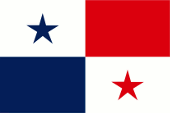 |
National-, Handels- und Marineflagge – national, merchant and naval flag, Seitenverhältnis – ratio = 2:3, Quelle/Source, nach/by: Corel Draw 4   |
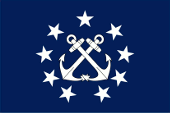 |
Gösch – naval jack, Seitenverhältnis – ratio = 2:3, Quelle/Source, nach/by: Wikipedia (EN) |
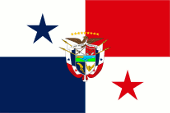 |
Präsidentenstandarte – Standard of the president, Seitenverhältnis – ratio = 2:3, Quelle/Source, nach/by: Wikipedia (EN), Corel Draw 4 |
| Die
Flagge Panamas ist gevierteilt und zeigt eine Kombination der Farben Weiß,
Rot und Blau. In den beiden weißen Flächen jeweils ein blauer bzw. roter
fünfzackiger Stern. Sie wurde am 03.11.1903 erstmals gehisst (nach anderen Quellen am 03.11.1903 oder am 20.12.1903), und am 04.06.1904 offiziell bestätigt. Das Gesetz Nummer 48 von 1925 bestätigte die Flagge und definierte ihr Aussehen exakt, auch die Farben, wobei hier nur "Rot" und "Blau" genannt werden, ohne die Farben zu spezifizieren. In der Praxis werden ein kräftiges Rot und ein dunkles Blau verwendet, wobei Pantone 2768 für Blau und Pantone 1788 für Rot nahe kommen. |
The flag of Panama is quartered and shows a combination of the colours white, red and blue. In the both white fields each one blue respectively red fivepointed star. It was hoisted for the first time on 3rd of November in 1903 (by other sources on 1st of November in 1903 or 20th of December in 1903), and officially confirmed on 4th of June in 1904. The law number 48 of 1925 confirmed the flag and defined its appearance exactly, including the colours, although only "red" and "blue" are mentioned here without specifying the colours. In practice, a strong red and a dark blue are used, with Pantone 2768 for blue and Pantone 1788 for red coming close. |
| Die Farben Rot und Blau sollen die Farben der beiden politischen Parteien sein, Rot steht für die Liberalen (Colorados), Blau für die Konservativen, Weiß für den Frieden zwischen beiden. Der blaue Stern steht für bürgerliche Ehrlichkeit und Rechtschaffenheit, der rote Stern für Gesetz und Ordnung im Staat. Ebenso sollen die Sterne die beiden Städte auf beiden Seiten des Panamakanals darstellen: Panama am Pazifischen Ozean, Colon am Karibischen Meer. Aber, nicht von ungefähr erinnert die Flagge an diejenige der USA, den Geburtshelfer Panamas. Sie ist ein Entwurf des ersten panamaischen Präsidenten Manuel Amador Guerrero. | The
colours red and blue should be the colours of the both political parties.
Red stands for the Liberals (Colorados) and blue for the Conservatives and
white for the peace between them. The blue star stands for common honesty
and uprightness, the red star for law and order in the state. Just as should
the stars represent the both towns on both sides of the Panama Canal: Panamá
at the Pacific Ocean, Colon at the Caribbean Sea. But, not accidentally the
flag remembers the stars and stripes banner of the USA, the obstetrician of
Panama. It is a design by the first president of Panama Manuel Amador
Guerrero. |
| Quelle/Source: Flaggen Wappen Hymnen, Flaggen und Wappen der Welt | |
Wappen – Coat of Arms: |
|||
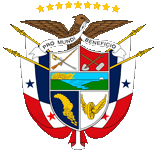 |
Wappen von Panama – Coat of arms of Panama, Quelle/Source: Corel Draw 4
|
| |
| Das Staatswappen wurde 1904 eingeführt. Die Waffen im weißen Feld links oben erinnern an die gewaltsame Trennung von Kolumbien. Die Werkzeuge im roten Feld rechts oben erinnern an den Bau des Panamakanals. Im großen Mittelfeld ein Landschaftsbild. Es zeigt die durchbrochene Landenge von Panama sowie Sonne und Mond. Im blauen Feld unten links ein goldenes Füllhorn. Es steht für den durch den Kanal zu erwartenden Reichtum. Im weißen Feld rechts unten ein goldenes Flügelrad. Es steht für den Verkehr. Die neun Sterne repräsentieren die neun Provinzen des Landes. | The coat
of arms of the state was introduced in 1904. The weapons in the white left
up field remember the violent separation from Colombia. The tools in the red
right up field remember the construction of Panama Canal. In the big midfield a scenery. It shows the broken down Isthmus of Panama as well as sun and moon. In the blue left down field a golden cornucopia. It stands for the by the canal to expect wealth. In the white field right below a golden wing-wheel. It stands for the traffic. The nine stars represent the nine provinces of the country. |
| Quelle/Source: Flaggen Wappen Hymnen | |
Flugzeugkokarde – aircraft roundel: |
|
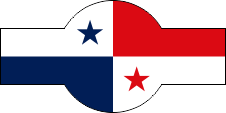 |
Flugzeugkokarde – aircraft roundel Quelle/Source, nach/by: Wikipedia (EN) |
Landkarte – Map: |
Lage – Position: |
Landkarte des Landes – Map of the Country: |
|
|
| Zahlen und Fakten – Numbers and Facts: | |
|
|
|
|
|
|
|
|
|
|
|
|
|
|
|
|
|
|
| 1501 ·
Entdeckung der Nordküste und Inbesitznahme für Spanien durch den spanischen
Seefahrer Rodrigo Galván de Bastidas 1513 · der Spanier Vasco Núñez de Balboa durchquert als erster Europäer die Landenge von Panama und erblickt den Stillen Ozean 1516 · Gründung der Stadt Panamá, Kolonisierung des Landes, Anschluss an das Vizekönigreich Peru 1739 · Bildung des Vizekönigreichs Neugranada, welches die heutigen Staaten Kolumbien, Venezuela, Ekuador und Panama umfasst 20.07.1810 · Proklamation der Unabhängigkeit Neugranadas von Spanien 1810–1819 · Unabhängigkeitskrieg gegen Spanien unter der Führung von Simón Bolívar 1819 · Proklamation der Republik Großkolumbien (ehemaliges Vizekönigreich Neugranada) 1830 · Venezuela und Ekuador spalten sich durch Bürgerkriege von Großkolumbien ab, Großkolumbien wird in Republik Neugranada umbenannt 1856 · militärische Intervention der USA 1858 · die Republik Neugranada wird in Granadische Konföderation (Kolumbien) umbenannt 1860 · militärische Intervention der USA 1861 · Proklamation der Vereinigten Staaten von Kolumbien 1885 · militärische Intervention der USA 1886 · Proklamation der Republik Kolumbien 1895 · militärische Intervention der USA 1901–1902 · militärische Intervention der USA 03.11.1903 · Abspaltung Panamas von Kolumbien auf Betreiben der USA 18.11.1903 · Hay-Bunau-Vertrag zwischen den USA und Panama, die USA pachten die Kanalzone "auf ewige Zeiten" 15.08.1914 · Eröffnung des Panamakanals 25.01.1955 · Revision des Kanalpachtvertrages zwischen den USA und Panama 1968 · Militärputsch 1973 · erste Bestrebungen Panamas die Souveränität über die Kanalzone zurückzuerhalten 07.09.1977 · Torrijos-Carter-Vertrag → neuer Kanalzonen-Vertrag 01.10.1979 · der Torrijos-Carter-Kanalvertrag tritt in Kraft, etwa die Hälfte der Fläche der Panamakanalzone wird an Panama abgetreten, Verwaltung, Betrieb und Verteidigung der Panamakanzone unterstehen bis zum 31.12.1999 den USA und Panama gemeinsam 1989 · Kriegserklärung an die USA, Invasion durch US-Truppen 1996 · Vereinbarung zur Stationierung von US-Truppen am Kanal nach der Übergabe an Panama 14.12.1999 · Übergabe der Kanalzone an Panama 31.12.1999 · Panama erhält die volle Souveränitat über die Kanalzone |
| 1501 ·
discovery of the northern coast and appropriation for Spain by the Spanish
seafarer Rodrigo Galván de Bastidas 1513 · the Spaniard Vasco Núñez de Balboa ranges as first European the Isthmus of Panama and sees the Pacific Ocean 1516 · foundation of Panamá City, colonization of the country, annexion by the Vice-Kingdom of Peru 1739 · formation of the Vice-Kingdom of New Granada, which includes the today's countries Colombia, Venezuela, Ecuador and Panama 20th of July 1810 · proclamation of the independence from Spain by New Granada 1810–1819 · independence war against Spain under leadership of Simón Bolívar 1819 · proclamation of the Republic of Great Colombia (former Vice-Kingdom of New Granada) 1830 · Venezuela and Ecuador separate themselves by civil wars from Great Colombia, Great Colombia gets renamed in Republic of New Granada 1856 · military intervention of the USA 1858 · the Republic of New Granada gets renamed in Granadian Confederation (Colombia) 1860 · military intervention of the USA 1861 · proclamation of the United States of Colombia 1885 · military intervention of the USA 1886 · proclamation of the Republic of Colombia 1895 · military intervention of the USA 1901–1902 · military intervention of the USA 3rd of November 1903 · separation of Panama from Colombia under support of the USA 18th of Novemeber 1903 · Hay-Bunau-Treaty between USA and Panama, the USA lease the Canal Zone "for eternal times" 15th of August 1914 · opening of the Panama Canal 25th of January 1955 · revision of the canal leasing treaty between USA and Panama 1968 · military coup d’état 1973 · first ambitions of Panama to get back the sovereignty ober the Canal Zone 7th of Septemebr 1977 · Torrijos-Carter-Treaty → new Canal Zone Treaty 1st of October 1979 · the Torrijos-Carter Canal-Treaty comes into power, perhaps the half of the area of the Panama Canal Zone gets ceded to Panama, administration, operation and defense of the Panama Canal Zone will be mutual done until the 31st of December 1999 by the USA and by Panama 1989 · declaration of war to the USA, invasion by US-troops 1996 · agreement for stationing of US-troops at the canal after the handover to Panama 14th of December 1999 · handing over of the Canal Zone to Panama 31st of December 1999 · Panama gets the full sovereignty over the area, the Panama Canal Zone ends its existence |
| Quelle/Source: Atlas zur Geschichte, Weltgeschichte, Wikipedia (D) |
| Der Name "Panama" stammt aus der Sprache der indianischen Ureinwohner. Er bedeutet: "Fischreicher Ort". | The name "Panama" descents from the language of the native Indians. It means: "Place rich of Fishes". |
| Quelle/Source: Handbuch der geographischen Namen | |